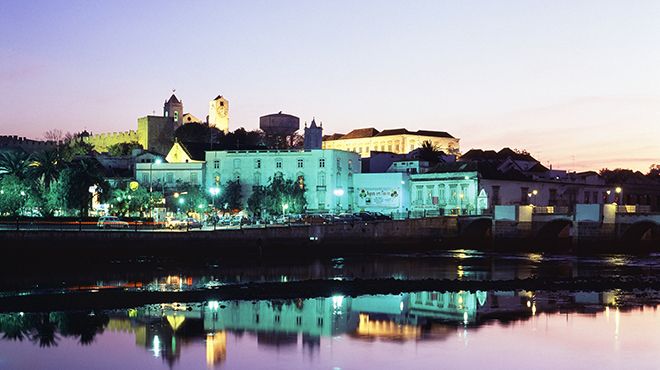Tavira

Tavira
Towns and Villages
In the Algarve, archaeological remains have been discovered tracing settlement back over 6,000 years. However, it was under the Roman empire that the southern coastline was settled in a more organised fashion. The city of Balsa was established in the 1st century ad on the route between Ossonoba (Faro) and Baesuris (Castro Marim). Its main activities were then fishing and fish salting. Benefiting from a favourable geographical location, between the Algarvian hills and the course of the Gilão river, it was also chosen by the Moors for settlement between the 8th and 9th centuries. It was then named "Tabira", root of the current Tavira. However, there is no conclusive evidence linking Balsa and Tabira to exactly the same site...
The Christian Reconquest took Tavira in 1242 under Paio Peres Correia, a knight of Sant'Iago. Two years later, king Sancho II gave these lands to the Order for their reorganisation and settlement. Also in the 13th century, the Castle and walls were strengthened and the Church of Santa Maria (Saint Mary) was built.
A period of great expansion began in the 15th century after the Conquest of Ceuta in 1415 that was itself to result in the Voyages of Discovery. It became an important fishing port and provided support to the armies and armadas that defended the Portuguese coast and the coastal cities that had been conquered to the north of Africa. It further exported salted fish, dried fruits, wine and other products. In 1489, king João II resided here for several months and in 1520 it became a city under Manuel I. This royal patronage was reflected in the architectural heritage and in the city's expansion.
Along the banks of the river and close to the main thoroughfares, more humble families took up residence while the nobility opted for the centre so as to be close to the political and administrative powers residing in the Castle. The Church of Misericórdia (Compassion) remains as witness to those times.
In the 17th century, Tavira remained a major commercial centre on the Algarve. From this period dates much of the cultural heritage further revealing a profound religious influence. Hence, there are today 21 churches in the city including the highlights of the Church of São Paulo (Saint Paul), the Church of Santo António (Saint Anthony), the Church of Carmo (Carmel) and the Church of São Francisco (Saint Francis).
In the course of the 18th century, Tavira lost economic prominence before recovering in the following century mostly due to tuna fishing and preserving.
In Tavira, attention also goes to the traditional residences with their latticed entranceways and "treasury" roofs. The latticed doors are made of strips of wood and allow for ventilation even when the windows and the doors themselves are closed. The "treasury" roofs are four-directional small roofs with each representing one room in the house. "Treasury" is the name given to the crossing of the beams on which the beams rest.
In the surroundings, don't miss a visit to the small village of Cacela Velha or to the small island of Tavira, a white sand beach, 11 Km long, which is integrated in the Ria Formosa Natural Park. The connections between Tavira and the island are assured by a regular boat line (departing from the city market or from a place called "Quatro Águas") and by taxi-boats.
The Christian Reconquest took Tavira in 1242 under Paio Peres Correia, a knight of Sant'Iago. Two years later, king Sancho II gave these lands to the Order for their reorganisation and settlement. Also in the 13th century, the Castle and walls were strengthened and the Church of Santa Maria (Saint Mary) was built.
A period of great expansion began in the 15th century after the Conquest of Ceuta in 1415 that was itself to result in the Voyages of Discovery. It became an important fishing port and provided support to the armies and armadas that defended the Portuguese coast and the coastal cities that had been conquered to the north of Africa. It further exported salted fish, dried fruits, wine and other products. In 1489, king João II resided here for several months and in 1520 it became a city under Manuel I. This royal patronage was reflected in the architectural heritage and in the city's expansion.
Along the banks of the river and close to the main thoroughfares, more humble families took up residence while the nobility opted for the centre so as to be close to the political and administrative powers residing in the Castle. The Church of Misericórdia (Compassion) remains as witness to those times.
In the 17th century, Tavira remained a major commercial centre on the Algarve. From this period dates much of the cultural heritage further revealing a profound religious influence. Hence, there are today 21 churches in the city including the highlights of the Church of São Paulo (Saint Paul), the Church of Santo António (Saint Anthony), the Church of Carmo (Carmel) and the Church of São Francisco (Saint Francis).
In the course of the 18th century, Tavira lost economic prominence before recovering in the following century mostly due to tuna fishing and preserving.
In Tavira, attention also goes to the traditional residences with their latticed entranceways and "treasury" roofs. The latticed doors are made of strips of wood and allow for ventilation even when the windows and the doors themselves are closed. The "treasury" roofs are four-directional small roofs with each representing one room in the house. "Treasury" is the name given to the crossing of the beams on which the beams rest.
In the surroundings, don't miss a visit to the small village of Cacela Velha or to the small island of Tavira, a white sand beach, 11 Km long, which is integrated in the Ria Formosa Natural Park. The connections between Tavira and the island are assured by a regular boat line (departing from the city market or from a place called "Quatro Águas") and by taxi-boats.




 Explore
Explore 
 Remember and Share
Remember and Share 


